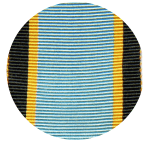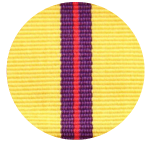Australian Service Medals and Decorations
Australian service medals and decorations are official symbols of service in the Australian Defence Force. They are divided into two main categories: service medals, awarded for general service in war or warlike zones, and bravery medals, given for specific acts of courage. Each medal is unique, with its own distinct ribbon colour. Understanding these ribbon colours can help you decode a record of service.
Ribbon Colours and their Meanings
Some ribbon colours represent those who served:
- Army: Red or Green/Khaki
- Navy: Dark Blue or White
- Air Force: Light Blue
- Australian Defence Force: Purple (a combination of the three)
Other colours symbolise the places where service members fought, often carrying multiple meanings:
- Country: National Flag or national colours
- Green: Represents both the Army and jungle warfare
- White: Symbolises the Navy, Arctic convoys or peace
- Yellow: Denotes deserts, beaches, the sun, or Asia
Decoding Common Ribbon Colours

Boer War King’s South Africa Medal
The green, white and orange stripes reflect the colours of the South African Republic and Orange Free State where the conflict occurred.

First World War 1914/15 Star (Gallipoli)
The red, white, and blue striped ribbon represents the British Empire, reflecting the colours of the British Union Jack and the Australian National Flag.

First World War Victory Medal
The rainbow ribbon symbolises the unity of the victorious Allied nations and the calm after the storm of war.

Royal Red Cross (Military Nurses)
The blue central stripe represents the traditional nurse's uniform, with red stripes signifying the Red Cross and military service.

Second World War 1939-45 Star
The dark blue, red, and light blue stripes signify equal contributions of the Navy, Army, and Air Force across all fronts.

Second World War Africa Star
The wide red stripe represents the Army, with narrower naval and air force blues on a desert-coloured background, reflecting their involvement in the campaign.

Second World War Pacific Star
The red edges and blue stripes symbolise engagement levels, while the green and gold centre represents the jungle and beaches.

Second War War Air Crew Europe Star
Primarily Air Force blue. Narrow stripes of black and gold reflect the night and day service of the air crews.

Korea Medal
Features three yellow stripes representing Asia, divided by two United Nations light blue stripes.

Vietnam Medal
Central red and yellow stripes reflect the Republic of Vietnam flag, with the Vietnam Logistics and Support Medal adding light brown for the waterways of Vietnam.

Anniversary of National Service 1951-72 Medal
Australia's ochre soil flanks the white, green and light blue of the Navy, Army and Airforce. The central blue and yellow stripes reflect the national colours of Australia as they were in that period.

Australian Active Service Medal (1975-present)
Predominantly Australian green and gold, with a central red stripe symbolising the dangers faced in conflict—a recurring theme in Australian service medals.

INTERFET Medal (East Timor)
The red central stripe, flanked by green, white, and UN blue, symbolises East Timor’s past and regrowth, and the service of the Army, Navy, and Air Force. It was the first Australian medal issued to other countries.

Iraq Medal
Iraq’s yellow desert sands surround Australian Defence Force purple and red for conflict on this ribbon

Afghanistan Medal
Stripes of khaki, white, and light blue represent the terrain, snow-capped mountains, and open sky, surrounding purple for the Australian Defence Force, with a central red stripe for conflict.
Discover More
Explore these and other medals in detail inside the Gallery of Medals at the Shrine of Remembrance. Free entry.
Updated
